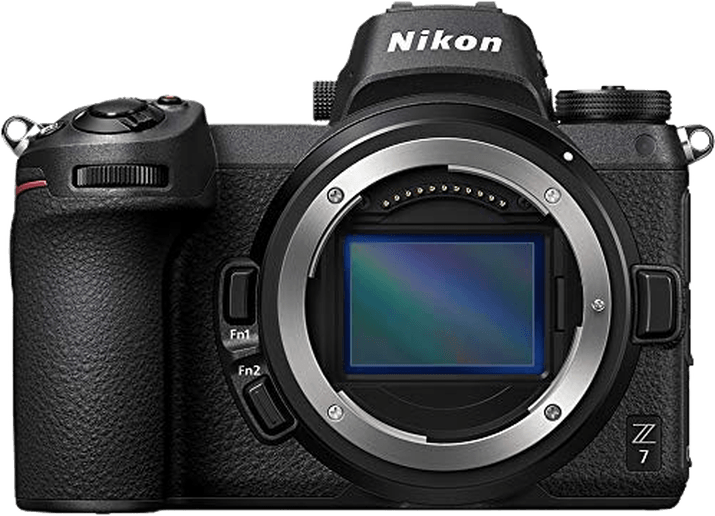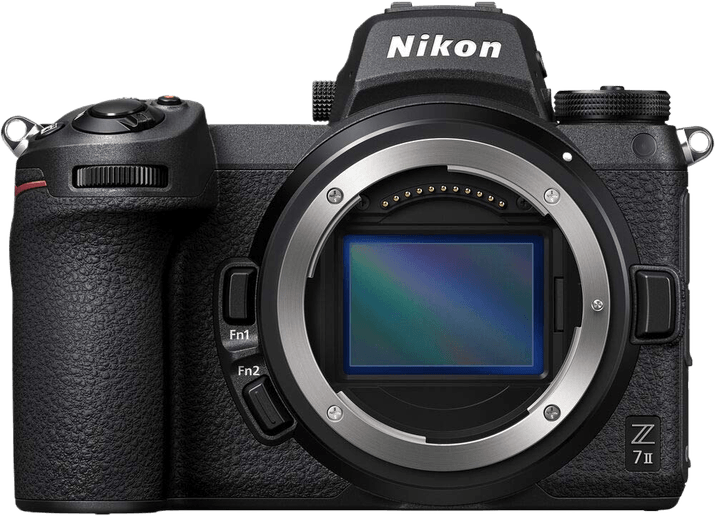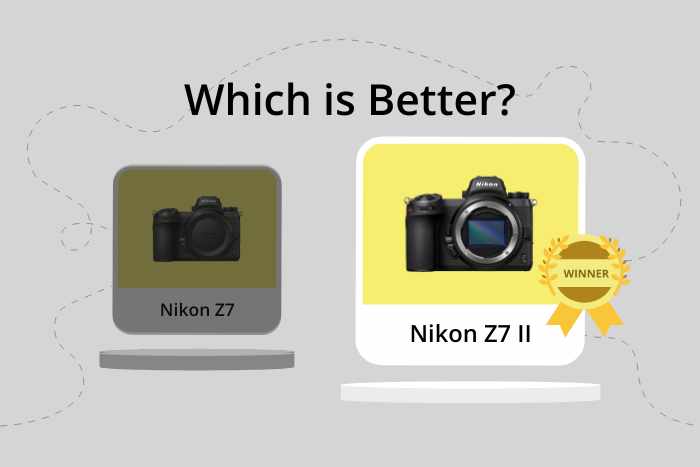Nikon Z7 vs Z7 II Comparison
Nikon Z7

Nikon Z7 II

The Nikon Z7 II takes the lead with a score of 85/100, while the Nikon Z7 trails behind with a score of 82/100. Both cameras share similarities, being mirrorless and having the same dimensions of 134 x 101mm. They differ in depth, with the Z7 II being slightly thicker at 70mm compared to the Z7’s 68mm. The Z7 II also weighs more at 705g, while the Z7 weighs 675g.
The Nikon Z7 II is a better camera due to its improved performance and features, which contribute to its higher score. Additionally, it was released in 2020, making it a more recent model with a launch price of $3399, just a dollar less than the Z7’s launch price of $3400 in 2018.
The Nikon Z7, however, is still a solid camera, offering great performance and features at a slightly lower score. Its advantage lies in its lighter weight of 675g, which could be beneficial for some photographers.
Taking all of these factors into account, the Nikon Z7 II stands out as the superior camera, offering better performance and features at a similar price. Meanwhile, the Nikon Z7 remains a good option for those who prioritize a lighter camera.
Nikon Z7 vs Z7 II Overview and Optics
The Nikon Z7 and Nikon Z7 II both score 86/100 in optics, showing no difference between the two cameras in this category. They share several common specifications, such as 45.7 and 45.75 megapixels, CMOS sensor type, full-frame sensor size, Nikon Z lens mount, and image stabilization. Additionally, both cameras employ an Expeed 6 processor, with the Z7 II featuring a dual Expeed 6 processor for improved performance.
The Nikon Z7 II has some advantages over the Z7, including a slightly higher shooting speed of 10 frames per second compared to the Z7’s 9 frames per second. Additionally, the Z7 II has a marginally better DXOMARK score for the sensor, receiving a score of 100 compared to the Z7’s 99. These improvements contribute to the Z7 II’s enhanced performance in certain situations, such as fast-paced action or sports photography.
On the other hand, the Nikon Z7 does not have any significant advantage over the Z7 II in terms of optics. Both cameras share the same score and most of the specifications, making them equally capable in most photography scenarios.
Given the similarities in optics between the Nikon Z7 and Nikon Z7 II, users can expect comparable image quality and performance. The Z7 II’s slight edge in shooting speed and sensor score may be beneficial for some photographers, but the differences are minimal. The choice between these two cameras will ultimately depend on individual preferences and requirements, as both offer exceptional optics and image quality.
Nikon Z7 vs Z7 II Video Performance
The Nikon Z7 II emerges as the winner in terms of video capabilities, with a score of 91/100 as compared to the Nikon Z7’s 83/100. Both cameras share common specifications, such as 4K max video resolution and 3840 x 2160 max video dimensions. Additionally, both cameras feature built-in time-lapse functionality.
The Nikon Z7 II outperforms the Nikon Z7 in video frame rate, offering a maximum of 120fps, while the Nikon Z7 provides up to 60fps. This higher frame rate in the Z7 II allows for smoother and more detailed slow-motion footage, making it a better choice for videographers and filmmakers who require this feature.
On the other hand, the Nikon Z7 still provides a decent video frame rate of 60fps, which is suitable for many video applications. Although it falls short compared to the Z7 II, the Nikon Z7 remains a capable option for those who do not require the higher frame rate.
Taking into account the higher video score and superior frame rate, the Nikon Z7 II proves to be the better choice for video capabilities. However, the Nikon Z7 remains a competent option for those with less demanding video needs. Both cameras offer excellent video quality, but the Z7 II’s enhanced frame rate gives it an edge over its predecessor.
Nikon Z7 vs Z7 II Features and Benefits
The Nikon Z7 and Nikon Z7 II both have a feature score of 87/100, making them equally competitive in terms of camera features. These cameras share several specifications, which contribute to their identical scores. Both cameras have a 3.2-inch screen with a resolution of 2,100,000 dots, providing clear and detailed display. They also feature touchscreens and flip screens, ensuring user-friendly control and versatile shooting angles.
In addition, neither camera has GPS functionality, but they are both equipped with WIFI and Bluetooth connectivity. This allows users to transfer images and control the cameras remotely, enhancing the overall shooting experience.
Despite the equal feature scores, the Nikon Z7 II may have some advantages over the Nikon Z7. The Z7 II features a dual card slot, which the Z7 lacks, providing more storage options and flexibility. It also has an improved autofocus system, making it faster and more accurate than its predecessor. Furthermore, the Z7 II has a longer battery life, allowing users to shoot for extended periods without needing to recharge.
On the other hand, the Nikon Z7 has a slightly lighter body, making it more portable and comfortable to hold for longer periods. However, this difference is minimal and may not significantly impact the shooting experience.
Given their identical feature scores and overlapping specifications, both the Nikon Z7 and Nikon Z7 II are excellent choices for photographers. The Z7 II has some improvements over the Z7, such as the dual card slot and enhanced autofocus system, which may make it a more appealing choice for some users. However, the Nikon Z7’s lighter weight may be a deciding factor for those who prioritize portability. Ultimately, the decision between these two cameras will depend on individual preferences and shooting needs.
Nikon Z7 vs Z7 II Storage and Battery
The Nikon Z7 II outperforms the Nikon Z7 in storage and battery, scoring 71 points compared to the Z7’s 35 points. Both cameras have USB charging and use EN-EL batteries, with the Z7 using the EN-EL15b and the Z7 II using the upgraded EN-EL15c.
The Z7 II offers superior storage options, featuring two memory card slots that accept SD, CFexpress Type B / XQD (UHS-II compatible) cards. In contrast, the Z7 has only one memory card slot and accepts only XQD cards. This difference allows the Z7 II to provide more storage flexibility and reliability.
In terms of battery life, the Z7 II also excels with 420 shots per charge, while the Z7 falls short with 330 shots. The Z7 II’s improved battery type, the EN-EL15c, contributes to its extended battery life.
Although the Nikon Z7 has a lower score in storage and battery, it still offers decent battery life and storage capabilities for casual photographers. However, the Nikon Z7 II is the clear winner in this comparison, providing better storage options and longer battery life, making it more suitable for professional use and demanding shooting situations.
Nikon Z7 vs Z7 II Alternatives
Still not ready to make a decision? Check out our other popular camera comparisons for inspiration:

